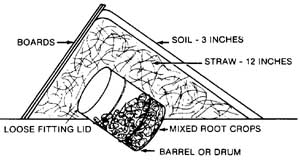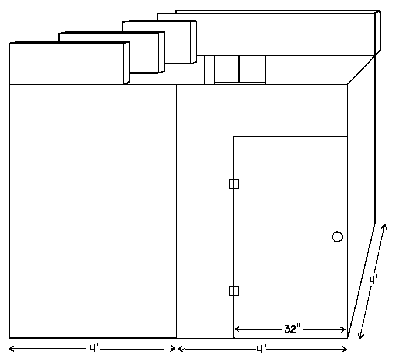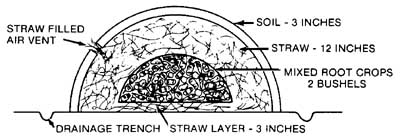by Sastry S. Jayanty* (7/15)
Quick Facts…
- Fruits and vegetables can be stored long after the season when handled and stored properly. The important aspects to proper storage are temperature, humidity, and ventilation. Separate fruits and vegetables in storage.
- Harvest fruits and vegetables early in the morning or on a cool day for better quality. Some fruits and vegetables should only be stored at room temperature. Straw, hay, wood shavings can be used to stabilize temperatures.
- Root crops should be harvested before the soil freezes. Root vegetables need cool, moist storage indoors or outdoors to remain usable until late winter. Pits or mounds can be used for outdoor root storage.
Fruits and vegetables from the garden can add both extra nutritional value and appeal to meals. Often home gardeners have excess fruits and vegetables that cannot be consumed immediately. When handled and stored properly, fruits and vegetables can be kept long after the season. They require different storage methods and can be stored for various lengths of time.
Harvesting
Fruits and vegetables should be harvested close to the peak of their maturity for high quality and good taste. Harvest early in the morning or on a cool day. Avoid cuts and bruises while harvesting. Never leave the produce in direct sun after harvest and only store produce that is free from disease and any other visual symptoms of damage. Washing the produce is optional, but if washed, produce should be dried using paper towels before storing, as excess moisture can cause mold and rot.
Root crops such as potatoes, beets and carrots need to be harvested before the soil freezes. Potatoes should be harvested after the vines die so that the potato skin has a chance to mature, making them less susceptible to bruises, cuts, and moisture loss during storage.
Harvest onions soon after the tops fall over. Pungent onions store longer than mild onions. After harvest, onions needs to be conditioned for 2 to 3 weeks under relatively warm, dry conditions; when the leaf stalks rustle upon handling, they are ready to move to a cool, dry storage area.
Table 1. Common vegetables and fruits storage conditions
| Storage Conditions | # of months |
| Room temperature | Tomatoes |
| Cool and Moderately moist | Celery, Leeks |
| Cool and Moderately moist | Beets, Pears |
| Cool and Moderately moist | Apples, Pumpkins, Squash |
| Cool and Moist place | Carrots, Potatoes |
| Cool and Dry Place | Onions |
Storage
 |
Figure 1: An outdoor barrel storage pit. |
Methods of storage and length of storage depend on the kinds and types of fruits and vegetables. There are three critical aspects to consider in properly storing vegetables: temperature, humidity and ventilation. Many fruits and vegetables should be stored only at room temperature because refrigerator temperatures damage them or prevent them from ripening to a good flavor and texture. It is advisable to separate the fruits from vegetables to minimize the detrimental effects of ethylene produced by the fruits on the vegetables.
Refrigerator Storage
The storage life of most common fresh fruits and leafy vegetables is highly variable, but is usually not much longer than one week in a refrigerator crisper, when wrapped in perforated plastic bags. Moisture can accumulate in unperforated plastic bags, which can lead to growth of mold or bacteria. Some fruits, such as melons, cantaloupe, honeydew, peaches, pears and nectarines, need to be stored at room temperature until ripe. Fruit pieces cut from fully ripe fruit can also be successfully stored in the refrigerator.
 |
Figure 3: A basement storage area in the corner of a basement with a window. Walls are three sheets of 4 x 8-foot 3/8-inch plywood. Cut a 7-foot x 32-inch door in one sheet. Insulate the ceiling and interior walls. Build shelves and bins around all walls inside the storage area. Leave a small walkway near the door. |
Basement, Cellar or Attic Storage
Vegetables such as carrots, beets, turnips, and potatoes, may be stored in a cool, moist location and remain in usable condition until late winter. Adequate storage conditions can be found in a typical home; for example, basements are generally cool and dry, while root cellars provide cold and moist conditions. It is important to provide ventilation and protection from rodents when storing vegetables in cellars and basements; another important consideration is to stabilize storage temperature using, materials such as straw, hay, or wood shavings as insulation.
Outdoor Storage
Outdoor structures can be used to store small amounts of vegetables such as potatoes, carrots, beets, turnips, parsnips, and cabbage, and can also be used for storing appropriate varieties of apples and pears. Outdoor storage structures include pits and mounds, which can be constructed partly or entirely below ground.
Outdoor Pit
The most common way to form a pit is by putting a metal or plastic barrel in the ground (see Figure 1). This is most effective for root vegetables. After placing these in the barrel, the lid should be put loosely in place to allow for air transfer. Cover the barrel with straw held in place by a layer of soil. The straw should be 1 to 3 feet deep, depending upon the expected low temperatures that must be endured. The unlined pit must be dug in an area where water will not fill the pit and where rodents are not a problem.
Storage Mound
 |
Figure 2: A storage mound. |
A storage mound (see Figure 2) is similar to the unlined pit. It is used where groundwater may become a problem or where only a short storage period under mild temperatures is anticipated. The vegetables are piled on a layer of straw on top of the ground, then covered with a layer of straw that is held in place by a layer of soil. The mound usually contains no more than one or two bushels of mixed root vegetables, so when the covering is removed, all the produce can be taken into the home.
For protection during the coldest months of December, January, and February, the soil layer over the mound should be six to 10 inches thick. Limited quantities of vegetables may be kept in the refrigerator in order to reduce the problem of frequent removal from the soil mound.
Sources
-
- Storing vegetables and fruits in basements, cellars, outbuildings, and pits. Home and Garden Bulletin No. 119 US Department of Agriculture 1968.
- Tong, Cindy, Harvesting and Storing Home Garden Vegetables, University of Minnesota Extension Service. https://extension.umn.edu/planting-and-growing-guides/harvesting-and-storing-home-garden-vegetables
- Van Laanen, Peggy and Amanda Scott, Safe Storage of Fresh Fruits and Vegetables, Texas Cooperative Extension System, Texas A&M University System. https://oaktrust.library.tamu.edu/bitstream/handle/1969.1/87212/pdf_1902.pdf?sequence=1&isAllowed=y
*Sastry S. Jayanty Ph.D., Associate Professor and Extension Specialist, Potato post-harvest physiologist at San Luis Valley Research Center, Department of Horticulture and Landscape Architecture, Colorado State University. Revision of original fact sheet no. 7.601 (7/92, reviewed 3/08) by J.E. Ellis, C.J. Jorgensen and D. Whiting. Revised 7/15.
Colorado State University, U.S. Department of Agriculture, and Colorado counties cooperating. CSU Extension programs are available to all without discrimination. No endorsement of products mentioned is intended nor is criticism implied of products not mentioned.
Go to top of this page.





